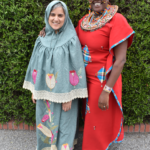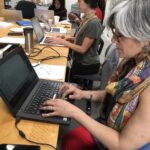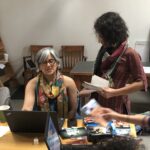Seeing Sahiyo Stories on Female Genital Cutting Come to Life
Written by Voices To End FGM/C. Posted in Sahiyo blog, Uncategorized
By Mariya Taher
As an alumni of the Women’s Foundation of California’s Women’s Policy Institute, I was invited to attend a storytelling workshop hosted by StoryCenter in March 2017, in which I created a digital video story about my advocacy work to end Female Genital Cutting (FGC). I advocate against FGC because for centuries, women have been afraid to speak up–they fear being socially ostracized from their community, being labeled a victim, or getting their loved ones in trouble. For too long, a silence on this form of violence has existed within this country.
I strive to be one of the individuals who continues to break that silence.
The result from the workshop was Shattered Silences, a video discussing my experience as a survivor of FGC and the power of storytelling in inspiring other women and men to come forward and speak against this harmful practice that has persisted for generations because of our community’s silence.
After participating in the workshop, and after seeing my video go live, I felt much pride in knowing I had shared my story, and most importantly, I felt that I had gained control over how I told my story. Since 2016, as my work on FGC has increased, and my name has become more publicly associated in media articles related to FGC, I have seen again and again how my story has been taken out of context and told by others in a way that at times has felt exploitive, or not quite right. (Watch American Survivors of Female Genital Mutilation/Cutting Speak Out ). Creating Shattered Silences allowed me to take back agency over my story, which I had seen used to promote Islamaphobia and anti-immigrant fear, and tell it in a way that felt comfortable and in line with the message I wanted to share with others.
I began to wonder that if I felt that way, then perhaps other women and girls living in communities where FGC occurs might also feel that way. Soon after I had the idea of hosting a StoryCenter workshop focused on FGC, to bring together other women living in the U.S. who have been affected by FGC or who have family members who have been affected by FGC, and who wanted to lend their voices to ending this harmful practice in the United States, and globally.
Most people falsely believe FGC exists only in other parts of the world, and could never occur in the United States. But in April 2017, that misconception was shattered when a Detroit doctor was arrested for performing FGC on two seven-year-old girls. This doctor belonged to the same religious sect, Dawoodi Bohra, I grew up in, and the case showed that though laws banning the practice exist, FGC does continue to affect women living in the U.S.
I also wanted to show that FGC affects U.S. residents who come from all different backgrounds (economic, religious, education level, racial/ethnic, etc.).
For the next year, I fundraised to do just such a thing, and in May 2017, I called on my family, friends, and community to help bring an end to the silence around FGC and the practice by donating to a campaign to allow more women living in the United States to produce and share their stories publicly. The campaign raised close to $8,000, and in the fall of 2017, the Wallace Global Fund came onboard to provide an additional $10,000 to ensure that the women’s stories would be distributed far and wide.
Finally, in May 2018, with support from Sahiyo volunteers, I hosted the workshop with Amy Hill from StoryCenter, Orchid Pusey from Asian Women’s Shelter, and nine women from all over the country, who came together to create digital storytelling videos. The participants included a mixture of women differing in race/ethnicity, age, and citizenship/residency status, yet the one thing we all have in common is that we live in the United States. The women included Renee Bergstrom, Zehra Patwa, Maria Akhter, Salma Qumruddin, Maryah Haidery, Leena Khandwala, Aisha Yusuf, Severina Lemachokoti, and myself.
The three day digital storytelling workshop at StoryCenter allowed these women (who are now my friends and allies in the work to end FGC) to come together in a supportive environment where we could heal and reclaim the piece of ourselves that was lost when we underwent FGC or learned of others in our family who experienced it. Every woman was at a different phases of coming to terms with FGC, from only recently learning they had undergone it and beginning to grapple with its emotional and physical impacts, to being staunch advocates working to prevent FGC from happening to other girls, and their digital stories reflect it. Our joint hope in creating the videos is that by telling our stories, we will move towards building that critical mass of voices needed to prompt social change and demonstrate that in every community where FGC occurs, there is an increasing trend of support for abandoning this harmful practice.
As a writer who has loved words since I first learned how to read, I know how powerful stories are in creating change in the world. They spark our emotions and wake us up to our reality. Too often in everyday life, we try and connect with each other on a rational level, but this isn’t always enough to change behavior. People must be emotionally engaged to understand what needs to be done. StoryCenter’s digital storytelling platform allowed women to be the creators in sharing their stories in the manner they feel most comfortable with.
Currently, the videos are in post-production, but when they are ready to be shared broadly, we all hope that our stories will engage the broader community so that we can all ensure that FGC does not happen to the next generation of girls. We’re working on creating partnerships with various organizations and groups to host screenings of the stories and to support workshop participants in attending those events so that they can be present to answer any questions arising from the audiences. After all, these stories are theirs, making the women who created the digital stories the best teachers of all in learning how to support survivors and end female genital cutting once and for all.
Learn More about Sahiyo Stories here or watch “The Making of Sahiyo Stories“.
If you would like more information about Sahiyo Stories or to host a screening with the videos, contact mariya@sahiyo.com.





